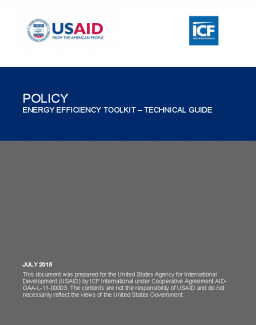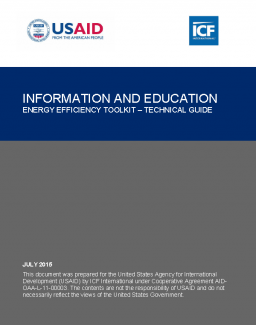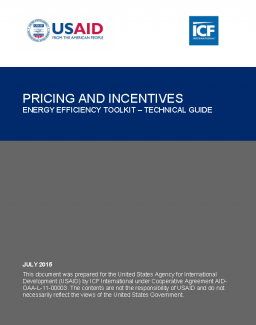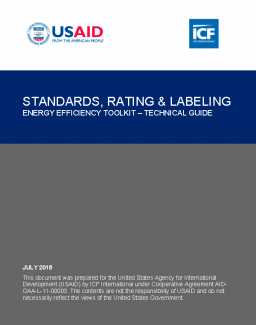Energy Efficiency Policy and Program Approaches
Energy Efficiency Toolkit
Energy efficiency policies and programs can be approached in many different ways. Learn how some designs and strategies are best suited for a particular energy sector while others can be applied across multiple sectors.
The success of energy efficiency activity is dependant on a local marketplace that provides regulatory, technical, financial, and informational support. Market readiness is demonstrated by the strength of six building blocks:
- smart incentives,
- regulatory mechanisms,
- skilled workforce,
- financing support,
- public awareness, and
- technology development.
These building blocks are usually not consistently strong in any one location. For example, an urban area may have energy-efficient technology easily available but lack financial incentives or financing mechanisms.
USAID can assess the strengths and weaknesses of key areas of local markets to determine effective policies and programs to advance energy efficiency. If a strong technical workforce is identified, for instance, USAID could promote public awareness of efficiency and payback opportunities in order to drive increased demand for energy-saving building upgrades. In another example, a high profile policy may be in place that mandates energy efficiency to meet green growth or climate resilience goals, but an analysis of the market may reveal that efficiency technology is not affordable and incentives are needed to achieve the policy’s goals.
The USAID Opportunity Assessment Tool was developed to understand market readiness for energy efficiency. The tool uses country-specific data to identify (1) opportunities for near-term programs and policies building on existing strengths, and (2) areas that need improvement in order for additional energy efficiency strategies to be successful.
Another important characteristic to consider in pursuing programs and policies is that investments in energy efficiency typically pay for themselves over short time frames through energy cost savings. As a result, programs do not need to be permanent to create change and should be designed for market transformation, not continued assistance. Factors affecting the adoption of energy efficiency include:
- Information about energy efficiency including consumer access to product information, and training for building operators on how to implement efficiency strategies.
- Policies and regulations, such as building codes and minimum energy performance standards (MEPS) for equipment. Energy codes and standards often are necessary to push the construction industry and technology manufacturers beyond business as usual.
- Financial incentives, which are important mechanisms to support consumers in making purchasing decisions when they are not convinced of the performance and savings they will receive.
Over time, interventions tied to these factors can be removed as the public comes to value efficiency and gain confidence in the delivery of the promised savings and performance.
Use the technical guides below to learn more about different types of energy efficiency policies and programs. The guides include specific project and program examples from around the world in the residential, commercial, industrial, transportation, and agricultural sectors. They describe key design and implementation considerations for Policy; Information and Education; Incentives and Pricing; and Standards, Rating, and Labeling.
Policy
Policies that encourage investments in energy efficiency play a critical role in the success of many programs and initiatives. Without such policies, many economically viable energy efficiency opportunities will remain unexplored despite the fact that investing in energy efficiency is a cost-effective approach to sustainable development. This technical guide outlines energy efficiency policies that have been successful in developed countries and are adaptable to developing-country contexts. The types of policies covered in this guide include energy pricing, taxes, efficiency targets and resource planning, energy sector regulation, and a variety of other policies aimed at facilitating the adoption of efficient technologies in the marketplace.
Information and Education
Information and education play an important role in demonstrating to key stakeholders the advantages of choosing to invest in energy efficiency. Initiatives can take the form of public service campaigns, technical and marketing trainings, and pilot projects. These initiatives help stakeholders engage with energy efficiency programs and understand how energy efficiency can add value to their households or businesses. They also help demystify the costs of investing in energy efficiency, which in turn promotes the growth and development of the energy services sector. An example of how information can be used to drive stakeholder action on efficiency can be seen in USAID’s 2014 utility assistance study in Tanzania. (A summary of the project approach appears in the Case Studies section of this toolkit.) The study team worked with utility staff to analyze data on customers and energy usage. A program portfolio was then developed to cost-effectively produce demand and peak savings.The process and data were transparent, and the utility could see clearly how the energy efficiency delivered by the new programs would help them alleviate their energy supply shortages.
Pricing and Incentives
Financial and nonfinancial incentives can help overcome barriers that prevent consumers from adopting new technologies and behaviors. At the same time, energy pricing structures can be designed to drive energy efficiency and conservation. In order for customers to appreciate the true value of energy efficiency, energy pricing should reflect the full cost of electricity production, transmission, and distribution, as well as take into account any negative externalities (i.e., costs to third parties) incurred along the way. Subsidies will, in general, dilute the benefits that end-users perceive from the energy efficiency investments they make. Government ministries or regulatory bodies are often best placed to fund and administer these incentive and pricing efforts and may support increased efficiency measures for low-income and other vulnerable populations. Utilities can also play a significant role in delivering energy efficiency programs if enabled by government and regulatory structures.
This technical guide discusses how financial incentives, nonfinancial incentives, and electricity pricing schemes can be harnessed to improve energy efficiency. It also describes the conditions that enable these strategies to be effective.
Standards, Rating, and Labeling
Standards, rating, and labeling schemes differentiate efficient products and buildings from those that are inefficient by establishing minimum energy performance standards. Such schemes help consumers save money and reduce energy consumption, and they help governments meet goals for national energy savings and targets for reducing greenhouse gases.
The energy savings potential from efficient products and buildings in the developing world is immense (PDF 4.2MB), particularly as energy demand is predicted to increase dramatically in some developing countries. Promoting efficient products and developing enforceable green building codes can save energy, ensure reliable electricity distribution, and improve the quality of life for underserved communities.
This guide outlines the essential components of standards, rating, and labeling schemes for products and buildings, highlighting key concepts and common challenges.




